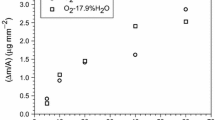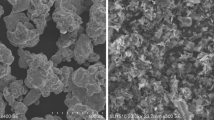Abstract
The oxidation and oxide spallation of 1%Cr–0.5%Mo low carbon steel disks in dry oxygen was studied isothermally at 800°C (1073 K) and in thermal cycling between 800 and 600°C (1073 and 873K) followed by cooling at rates from 3 to 100°C/min. Mostly parabolic oxidation kinetics were observed. Thin scales (10 μ) were more prone to spalling than thicker scales (20 μ). The thickness and growth imperfections of an inner scale layer enriched in chromium, molybdenum, and silicon strongly influenced the probability of cohesive failure exceeding that of adhesive failure of the scale. Cohesive failures in the bulk scale during thermal cycling were probably nucleated at voids and microcracks produced in the initial isothermal period of scale growth. The number of segmented scale layers that became detached during cycling was governed by the number of parallel rows of voids in the scale and not necessarily by the number of cycles.
Similar content being viewed by others
References
B. Ilschner,Corrosion and Mechanical Stress at High Temperatures, V. Guttman and M. Merz, eds. (Applied Science Publishers, London, 1981), p. 463.
J. K. Tien and J. M. Davidson,Stress Effects and the Oxidation of Metals, J. V. Cathcart, ed. (Metallurgical Society of the AIME, New York, 1975), p. 200.
D. L. Douglass,Oxidation of Metals and Alloys (American Society for Metals, Cleveland, 1970), p. 137.
P. Hancock,Stress Effects and the Oxidation of Metals, J. V. Cathcart, ed. (Metallurgical Society of the AIME, New York, 1975), p. 155.
R. Rolls,Rev. High Temp. Mat. 1, 397 (1973).
P. Hancock and R. C. Hurst,Adv. Corros. Sci. Technol. 4, 1 (1974).
R. F. Tylecote,J. Inst. Metals 78, 301 (1950).
A. K. Ghosh and R. Rolls,Iron Steel 42, 151 (1969).
G. J. Bateman and R. Rolls,Br. Corros. J. 5, 122 (1970).
J. M. Hulley and R. Rolls,J. Iron Steel Inst. (London)208, 1029 (1970).
R. Rolls and F. V. Arnold,Werkst Korros. 23, 886 (1972).
R. Rolls and F. V. Arnold,Corros. Sci. 16, 613 (1976).
J. J. Bickerman,J. Adhes. 3, 333 (1972).
R. J. Good,J. Adhes. 4, 133 (1972).
M. L. Williams,J. Adhes. 4, 307 (1972).
J. Stringer,Corros. Sci. 10, 513 (1970).
J. Stringer,Werkst. Korros. 23, 9 and 747 (1972).
D. Holmes and R. T. Pascoe,Werkst. Korros. 23, 10, 859 (1972).
D. L. Deadmore and C. E. Lowell,Oxid. Met. 11, 91 (1977).
J. L. Smialek,Met. Trans. (A) 9A, 309 (1978).
H. T. Michels,Met. Trans. (A) 9A, 873 (1978).
C. E. Lowell and D. L. Deadmore,Oxid. Met. 14, 325 (1980).
Author information
Authors and Affiliations
Rights and permissions
About this article
Cite this article
Rolls, R., Nematollahi, M. The influence of thermal cycling on the oxidation and oxide spallation of a 1%Cr–0.5%Mo low-carbon steel. Oxid Met 20, 19–35 (1983). https://doi.org/10.1007/BF00658125
Received:
Issue Date:
DOI: https://doi.org/10.1007/BF00658125




